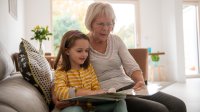How Preschools Can Set Up Intergenerational Relationships to Support SEL
Consistent interactions with senior citizens can be a valuable source of learning for preschool students.
It was early on a spring morning when a group of preschool students knocked on Grandma Bette’s door to present her with a May Day basket. When Bette saw the group at her door, her face lit up. She was a consistent fixture in their classroom, reading them books and working with them in small groups, and all the students were excited to surprise her. When Bette asked if she could join them during their other deliveries, the group enthusiastically agreed. They worked their way down the long hallway, knocking on doors as they went, and at every delivery, Grandma Bette proudly proclaimed, “These are my kids! This is my class!”
This interaction took place at All Seasons, a small preschool on the outskirts of Saint Paul, Minnesota. This school shares many characteristics common to early childhood education programs: collaborative construction with blocks, opportunities to be creative through art, and lots of chances to get dirty by exploring nature. But one thing that makes it unique is its location on the ground floor of a senior living center. This wasn’t a coincidence, but a purposeful decision to support one of the school’s core tenets of intergenerational learning.
Intergenerational Learning Supports Meaningful Relationships
Intergenerational learning (IL) is defined by groups like Generations United as the deliberate integration of interactions between generations in the learning environment and most often takes the form of senior citizens and early childhood learners. On the surface, this doesn’t seem out of the ordinary, as most school days involve interaction between kids and adults, but IL goes beyond informal interactions or one-off visits to senior care centers. The purpose is to create intentional and meaningful relationships between the children and older adults outside the student-teacher relationship that are deep and ongoing.
Schools like All Seasons that integrate IL into their curriculum facilitate frequent, often daily, visits between young learners and seniors with planned activities like games and crafts. Visits help to facilitate spontaneous moments through relationship building and the many benefits that come as a result.
Benefits of Intergenerational Learning
When young learners have the opportunity to interact with seniors, their literacy skills increase; they’re able to develop a larger vocabulary through conversations. They also develop important social and emotional learning (SEL) competencies like social awareness, empathy, and other elements of the CASEL 5 through their interactions. Teachers from All Seasons and other IL schools have observed that children who exhibit high levels of anxiety or hyperactivity tend to be more settled, as their interactions slow down and their energy becomes less intense to match the demeanor and energy of their senior partners.
These relationships can even prove crucial for kids in at-risk populations, as research has shown that one positive adult relationship can be the difference between becoming a success or a statistic. More often than not, senior citizens have time to be solely focused on the learners, which is as much a gift to the senior as it is to the child.
The benefits also go beyond the students, extending to the seniors as well. IL programs that focus on sustained relationship building have been found to counteract problems common among seniors like depression, loneliness, and even heart conditions, improving their quality of life while prolonging it. Repeated visits help create new neural pathways that combat the negative effects of isolation and even help to build greater resilience over time. One senior center director likened the effect of kids visiting to antidepressants after seeing how previously subdued seniors would instantly light up in the presence of children in a way they didn’t with their care providers.
4 Ways to Implement Intergenerational Learning
While only a small number of public and private schools share proximity to seniors like All Seasons, there are still many ways to integrate high-quality IL into classrooms:
Find a resource near you: Senior living centers are just one way to connect your learners to seniors in your community. Local churches are also a good option. Many have active senior groups that can come to you in case you can’t go to them. Community centers that host activities like fitness classes are another possible resource. When you find one in close proximity to your school site, make sure to specify that you’re looking for an ongoing collaboration, not a one-off visit. Are there seniors who’d be willing to come eat lunch or read to small groups once a week?
Construct a protocol: Integrating IL creates a new learning environment with rules and norms that are different from those of a normal classroom and are more akin to those of a library. Before a visit, students often need to be taught how to interact with seniors for meaningful relationships. Kids may need to speak louder or slower than usual. Ask them questions like “How do we talk to the seniors?” or “How do we act around the seniors?” You might also consider constructing something similar to a Social Story for kids and reviewing it before every visit to keep the expectations fresh in their minds.
Focus on quality: One willing senior who comes in more regularly is better than a group that you see infrequently, so focus there. What kind of role would create the best interactions? What activity is the best fit for your senior volunteer? Sometimes, sitting and listening to a small group read is a better fit than reading aloud to the group and helps learners gain confidence.
Let the seniors be the experts: IL doesn’t have to be relegated to early childhood. Older learners can also benefit if the structure of interactions shifts to more developmentally appropriate outlets. Allowing seniors a role as an in-class expert on subjects like history or one aligned to their life or career experience can help their visits become more relevant to older learners while facilitating relationship building.

